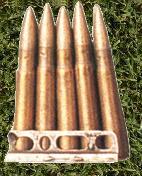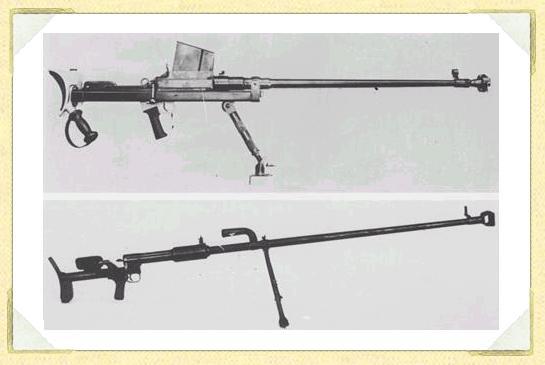



BOYS ANTI-TANK RIFLE
Boys Mark 1 with a Russian AT rifle.
United Kingdom
Royal Small Arms Factory, Enfield Lock,
0.55in SAA Boys/Boyes,
This weapon was developed in the mid 1930’s by the British Small Arms Committee and one of the principal designers was Captain Boyes. The Gun was originally code-named “Stanchion” but Boys died after the development had been completed while the weapon was being prepared for manufacture; as a mark of respect the Small Arms Committee decided that the weapon should be named after him.
The Boys Rifle was an enlarged bolt action weapon feeding from a top mounted magazine and equipped with a muzzle brake and a monopod firing support. The barrel was permitted to recoil in the stock and the butt was heavily padded-both measures to reduce the extraordinary recoil forces.
The bullet was steel-cored and was placed in a belted cartridge case, one of the few instances where this case-type has seen military use. The design was originally intended for high-powered sporting rifles, and the belt gave the base immense strength to resist high internal pressure. In 1940 a tungsten-cored bulletin a plastic/aluminium body was approved and issued, but shortly afterwards the Boyes was withdrawn from service and replaced by the PIAT.
In 1942 the gun had a brief return to popularity when a short-barrel Mark2 version was developed for use by airborne troops, but the requirement was dropped and the weapon was never adopted. Another attempt to revive it was the 1942 development of a taper-bore version; this was successful in trials as far as its penetrative performance went, but it was a singularly unpleasant weapon to fire (so, too, was the airborne model) and it was not accepted for service.
Length: 63.50in (1614mm)
Weight unloaded: 36lb 0oz (16.56kg)
Barrel: 36.00in (915mm), 7 grooves, right-hand twist
Magazine: 5-round detachable box
Muzzle velocity: c.3250fps (990mps)
Armour penetration: 21mm/300m/0º

